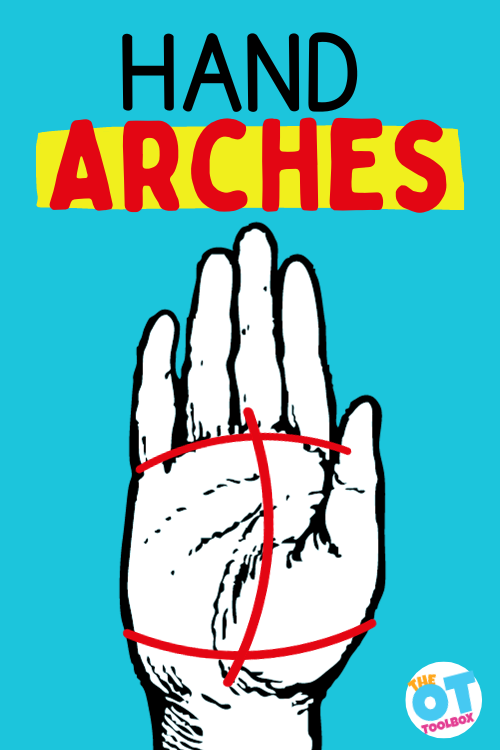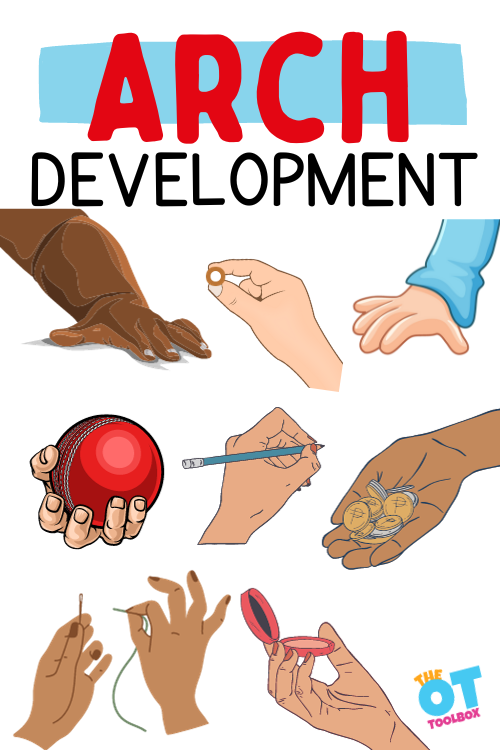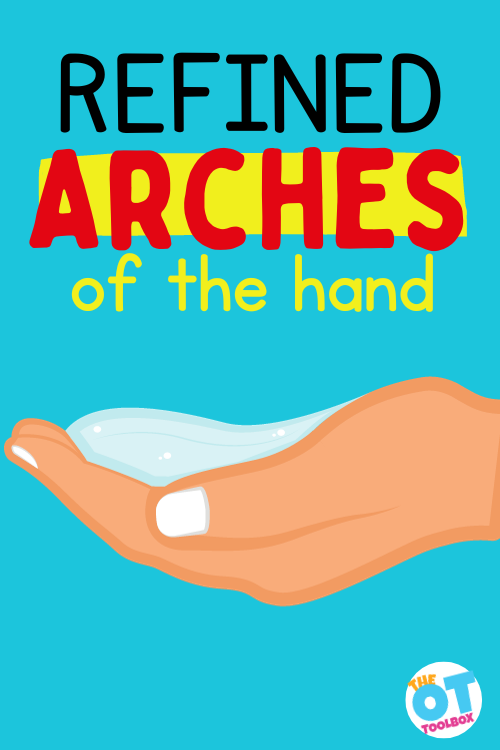Did you know there are several hand arches that make up the curve of the palm of your hand? It’s true! And, did you know that the arches of the hand and the shape of your hand affects fine motor skills, specifically hand strength, and supports finger dexterity, and endurance in daily life tasks? Hands have something we call “hand arches” and they are part of what allow us to use our hands in a variety of ways. That’s right – just as you have arches in your feet, you have arches in your hands! In this blog post, we’re covering arch development!

What are hand arches?
Hand arches refer to the curved surfaces of the palm of the hand, in three distinct planes, or curved places on the hand. The ability to control the hand arches allows the hand to mobilize and hold a variety of objects of different sizes. Refined hand arches allow the hand to cup water, hold a few coins, gently hold a small firefly, or curve the hand on a golf ball or basketball.
These hand arches are called:
- Proximal transverse arch- formed by the metacarpophalangeal joints (MCP joints) These are the joints at the base of each fingers. This arch does not mobilize as much as the other two arches, and offers stability.
- Distal transverse arch- formed by the distal row of carpal bones. These bones make up the wrist.
- Longitudinal arch- follows the curve of the fingers of the hand, from wrist to MCP joints.
Cup your hand into a position that would hold water. When you look at your hand, you can see a curved arch at the joints, closer to the thenar eminence, or bulk at the base of the thumb. These two transverse arches of the hand cross the hand and form a cupped position.
The longitudinal arch runs proximally to distally. This arch forms as the MCP joints of the fingers move closer to the wrist in a flexed, or curved position of the hand.
All three arches of the hand work together.

Arch Development
Arch development progresses from infancy. Refined arch development allows us to do so many things with the hands. The list below shows a progression of refined motor skills.
- Pinch small objects
- Pinch small objects while separating the sides of the hand to hold items within the palm of the hand
- Curve around balls or curved objects of various sizes
- Cup and hold items in the hand (several coins, small items like beads, etc.)
- Cup the hand to hold coins
- Create a curved surface to hold water in the hand
Refined arch development also lends itself to motoric control and precision in everyday tasks:
- pencil grasp
- tying shoes
- engaging zippers
- managing buttons
- opening small lids like toothpaste
- using a toothpick
- manipulating a paperclip
- threading a needle
- many other small motor tasks!
You can see there is a developmental progression at work here! Let’s go through Arch Development from infancy to preschool age:
Arches of the Hands- Birth to Toddlerhood
From the moment a child is born, their hands are on a journey of growth and grasp development. When we are first born, we use reflexive movements, or movements out of our control, to interact with the world. In the hands, the most well-known reflex is called the palmar grasp reflex. This is where their fingers curl around objects that are placed in their hands.
This is moving along the direction of one arch (the longitudinal arch); from fingertips to the bottom of the palm. You may do this same movement of opening and closing your fingers when you wave “hello”. As a baby grows, they gradually transition to voluntary grasping and releasing along this same path.
As toddlerhood approaches, you may notice children be able to hold and control items more and more. This is concurrent with the arches in their hands starting to develop, and their grasp becoming more refined.
In other words, the big palmar grasp that holds onto a rattle in infancy becomes more delicate to hold a piece of cereal in toddlerhood. This precision grasp is described as a pincer grasp.
As babies turn into toddlers, they no longer are moving just along that one arch to open and close the fingers- they are now forming and using the transverse arches.
These two arches run horizontally across the top and bottom of the palms. You can see all three arches in action while holding a tennis ball. This refined grasp pattern is known as a spherical grasp.
Arch Development in the Preschool Years
The development of the hand arches during the preschool years are a pre-writing skill needed for early handwriting and manipulation skills.
As children enter their preschool years, they should have a great baseline of arch development to build on. It’s time to refine and strengthen what they started as babies! This is an exciting time to build fine motor skills, hand control, and coordination. Preschoolers are able to use tools like crayons, markers, and scissors with increasing precision. They can string beads and pull zippers and take pride in their skills!
But all this play is really important work: proper arch development is essential for efficient pencil grasp and fluid handwriting without discomfort. This will one day impact their abilities and confidence as a student.
Encouraging a variety of activities that promote finger isolation and arch formation is crucial during this phase. That means limiting screen time and promoting purposeful play time!

To support refined arches of the hand, incorporating meaningful, play-based arch development activities is key.
Arch Development Activities
There are fine motor activities that foster intrinsic muscle strength which refine the arches of the hands.
How to encourage arch development in infancy:
Encourage exploration by providing various textures and shapes for them to grasp and manipulate. Blankets, books, balls, you name it! Just always be aware of safety when giving your infant any objects to explore.
Craft and Play Activity: Finger Painting Fun
Engage your little one in a finger painting session using non-toxic, washable paints. Encourage them to poke, smush, and smear with their hands. Offering a paint brush or paint stamps will engage different muscles of the hand, too!
This activity also promotes finger dexterity, hand-eye coordination, sensory development, and overall hand strength. Plus, you get to have an adorable piece of art in the end – talk about a win-win!
Craft and Play Activity: Playdough Party
Playing with play dough offers excellent opportunities for arch development. Encourage your child to roll, squish, poke, cut, and shape the dough using their fingers. Ask them to make tiny balls or create imaginative sculptures.
These activities promote finger strength, coordination, and the development of the intrinsic muscles that support the arches in the hands.
School Age: Handwriting Mastery and Beyond
As children progress into school age, their arches continue to mature, enhancing their ability to perform more intricate tasks. Handwriting becomes a focus, and proper arch development contributes to a stable pencil grasp, increased writing speed, and improved endurance.
This is what we mentioned in the preschool phase – where the arches can be a factor in academic success. Beyond that though, we may see development of the arches being used to play the violin, flute, or piano!
Craft and Play Activity: Lacing Adventures
Engage your child in lacing activities using lacing cards or threading beads onto a string. These tasks require finger manipulation, bilateral coordination, and arch support, helping strengthen hand muscles and promoting proper arch development.
This stage is usually where parents start to see the real strength of a child’s hands come into play – when their teachers note that they often struggle to open their lunch, zip their coat, or write for more than a few moments.
While things like increased screen time and decreased access to fine motor toys and tools can reduce hand strength, there are certain medical conditions that impact the development of the hands, too.
Medical Conditions and Arch Development:
Hypotonia: Low muscle tone can affect hand arch development, making fine motor tasks challenging. Common conditions with low muscle tone are Down Syndrome and Autism.
Hypermobility: Excessive joint mobility may lead to weak arches and difficulty with fine motor control.
Developmental Coordination Disorder (DCD): Children with DCD often experience difficulties with fine motor skills, limited strength of arch formation.
Occupational therapy interventions can support hand function and promote arch development in everyone!
The development of arches in children’s hands is a remarkable process that lays the foundation for fine motor skills and hand function throughout their lives. By understanding this journey, we can actively support and promote optimal arch development. It’s always easier than it sounds – just by engaging craft and play activities, we can nurture their hand muscles all while having fun!

Sydney Thorson, OTR/L, is a new occupational therapist working in school-based therapy. Her
background is in Human Development and Family Studies, and she is passionate about
providing individualized and meaningful treatment for each child and their family. Sydney is also
a children’s author and illustrator and is always working on new and exciting projects.
Working on fine motor skills, visual perception, visual motor skills, sensory tolerance, handwriting, or scissor skills? Our Fine Motor Kits cover all of these areas and more.
Check out the seasonal Fine Motor Kits that kids love:






Or, grab one of our themed Fine Motor Kits to target skills with fun themes:
- Frogs Fine Motor Kit
- Unicorns Fine Motor Kit
- Vehicles Fine Motor Kit
- Apple Fine Motor Kit
- Back to School Kit
- Sports Fine Motor Kit
- Outer Space Fine Motor Kit
- Fairytale Fine Motor Kit
- Plus more in our shop!
Want access to all of these kits…and more being added each month? Join The OT Toolbox Member’s Club!






